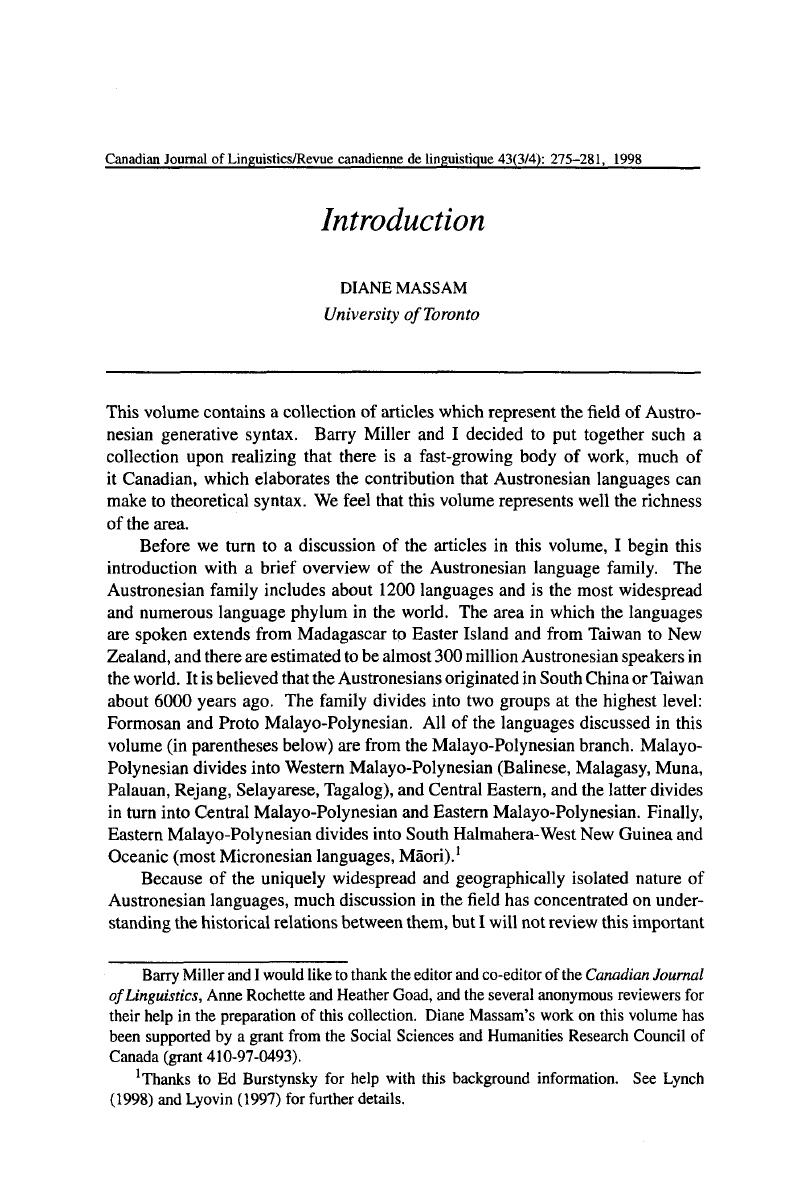No CrossRef data available.
Article contents
Introduction
Published online by Cambridge University Press: 27 June 2016
Abstract
An abstract is not available for this content so a preview has been provided. Please use the Get access link above for information on how to access this content.

- Type
- Articles
- Information
- Canadian Journal of Linguistics/Revue canadienne de linguistique , Volume 43 , Special Issue 3-4: Arguments and Structure in Austronesian Languages , December 1998 , pp. 275 - 281
- Copyright
- Copyright © Canadian Linguistic Association 1998
References
Biggs, Bruce. 1974. Some problems of Polynesian grammar. Journal of the Polynesian Society
83:401–426.Google Scholar
Blake, Barry. 1988. Tagalog and the Manila-Mt Isa Axis. La Trobe Working Papers in Linguistics
1.11–90,Google Scholar
Chung, Sandra. 1982. Unbounded dependencies in Chamorro grammar. Linguistic Inquiry
13:39–78.Google Scholar
Chung, Sandra. 1994. Wh-agreement and “referentiality” in Chamorro. Linguistic Inquiry
25:1–44.Google Scholar
Chung, Sandra, and Seiter, y. 1980. The history of raising and relativization in Polynesian. Language
56:622–638.Google Scholar
Clark, Ross. 1976. Aspects of Proto-Polynesian syntax. Auckland: Linguistic Society of New Zealand.Google Scholar
Cooreman, Ann, Fox, Barbara, and Givón, Talmy. 1988. The discourse definition of ergativity: A study of Chamorro and Tagalog Texts. In Studies in Austronesian Linguistics ed. McGinn, Richard, 387–426. Center for International Studies, Ohio University.Google Scholar
Finer, Daniel. 1997. Contrasting A-bar dependancies in Selayarese. Natural Language and Linguistic Theory
15:677–728.Google Scholar
Georgopoulos, Carol. 1985. Variables in Paulauan syntax. Natural Language and Linguistic Theory
3:59–94.Google Scholar
Georgopoulos, Carol. 1991. Syntactic variables: resumptive pronouns and A′ binding in Palauan. Dordrecht: Kluwer.Google Scholar
Guilfoyle, Eithne, Hung, Henrietta, and Travis, Lisa. 1992. Spec of IP and Spec of VP: Two subjects in Austronesian languages. Natural Language and Linguistic Theory
10:375–414.Google Scholar
Hale, Kenneth. 1968. Review of A profile generative grammar of Māori
, by Hohepa, Patrick W.. Journal of the Polynesian Society
77:83–99.Google Scholar
Hohepa, Patrick. 1969. The accusative-to-ergative drift in Polynesian languages. Journal of the Polynesian Society
78:295–329.Google Scholar
Hopper, Paul. 1988. How ergative is Malay? In Studies in Austronesian Linguistics ed. McGinn, Richard, 441–454. Center for International Studies, Ohio University.Google Scholar
Keenan, Edward, and Comrie, Bernard. 1977. Noun phrase accessibility and universal grammar. Linguistic Inquiry
8:63–99.Google Scholar
Kroeger, Paul. 1991. Phrase structure and grammatical relations in Tagalog. Doctoral dissertation: Stanford University.Google Scholar
Lynch, John. 1998. Pacific languages: An introduction. Honolulu: University of Hawai’i Press.Google Scholar
Lyovin, Anatole. 1997. An introduction to the languages of the world. Oxford: Oxford University Press.Google Scholar
Maclaughlin, Anna. 1996. Aspects of Ergativity in Tagalog. Doctoral dissertation, McGill University.Google Scholar
Massam, Diane. To appear. VSO and VOS: Aspects of Niuean word order. In The syntax of verb initial languages, ed. Carnie, Andrew and Guilfoyle, Eithne. Oxford: Oxford University Press.Google Scholar
Miller, Barry. 1988. Non configurationality in Tagalog Doctoral dissertation. University of Michigan.Google Scholar
Paul, Ileana, ed. 1998. UCLA Occasional Papers in Linguistics
20: The structure of Malagasy, vol. 2. University of California, Los Angeles.Google Scholar
Pearson, Matthew. 1996. Pied-piping into the left periphery. In Proceedings of NELS
27, ed. Kusumoto, Kiyomi, 321–335. GLSA, University of Massachusetts, Amherst.Google Scholar
Pearson, Matthew, and Paul, Ileana, eds. 1996. UCLA Occasional Papers in Linguistics
17: The structure of Malagasy, vol. 1. University of California, Los Angeles.Google Scholar
Rackowski, Andrea, and Travis, Lisa. To appear. V-initial languages: X or XP movement and adverb placement. In The syntax of verb initial languages, ed. Carnie, Andrew and Guilfoyle, Eithne. Oxford: Oxford University Press.Google Scholar
Richards, Norvin. 1997. What moves where when in which language? Doctoral dissertation, Massachusetts Institute of Technology.Google Scholar
Richards, Norvin. To appear. Another look at Tagalog subjects. In Formal issues in Austronesian linguistics, ed. Paul, Ileana, Phillips, Vivianne, and Travis, Lisa. Dordrecht: Kluwer.Google Scholar
Schachter, Paul. 1996. The subject in Tagalog: Still none of the above. UCLA Occasional Papers in Linguistics
15. University of California, Los Angeles.Google Scholar
Sperlich, Wolfgang. 1994. A theory of verb classes and case morphology in Niuean. Paper presented at the Seventh International Conference on Austronesian Languages, University of Leiden.Google Scholar
Tang, Chih-Chen Jane, Chang, Yong-li, and Ho, Dah-an. 1996. On noun phrase structures in Paiwan. Paper presented at the Formosan Workshop, Academia Sinica.Google Scholar
Verhaar, John. 1988. Syntactic ergativity in contemporary Indonesian. In Studies in Austronesian Linguistics, ed. McGinn, Richard, 347–386. Center for International Studies, Ohio University.Google Scholar
Wechsler, Stephen, and Arka, I Wayan. 1998. Syntactic ergativity in Balinese: An argument structure based theory. Natural Language and Linguistic Theory
16:387–441.Google Scholar




